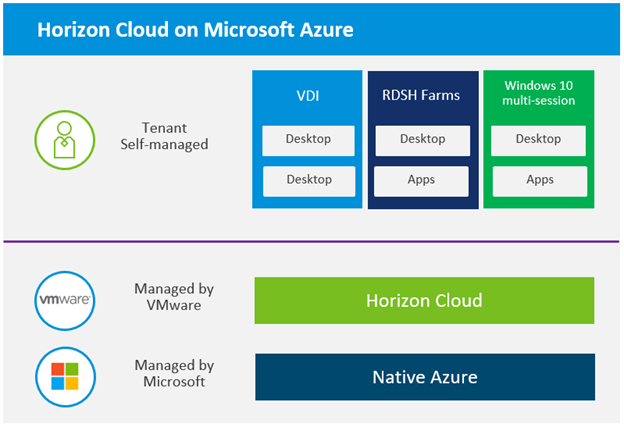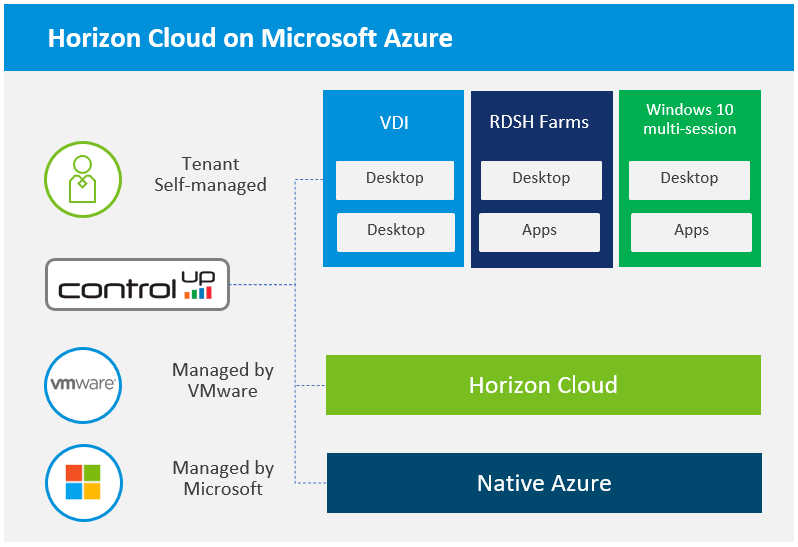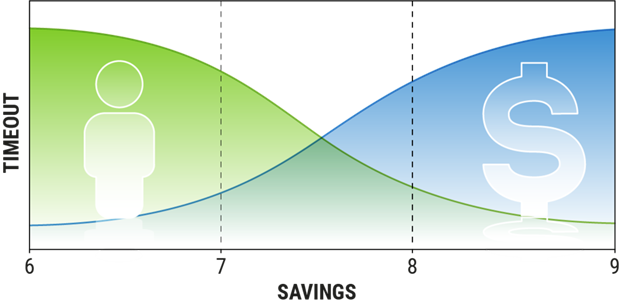This article was co-written by Sachin Sharma, Director of Product Marketing, VMware, and Tom Fenton, Technical Marketing Manager, ControlUp.
By now you (hopefully!) know how using ControlUp with VMware Horizon can help you optimize your end-users’ experience through real-time observations, deep analytics and reducing MTTR. Through tight integrations with the VMware software-defined datacenter (SDDC) stack, ControlUp can provide you with an end-to-end picture of your virtualized environments.
But not all VMware Horizon workloads leverage VMware SDDC. Horizon Cloud on Microsoft Azure, for example, lets you deliver desktops and apps that combine the power and management of VMware Horizon with the economies and unique capabilities of Microsoft Windows Virtual Desktop. This environment is deployed and managed from the same interface as on-premises VMware Horizon infrastructures, which results in a flexible, secure and manageable hybrid desktop and app virtualization platform.
With Horizon Cloud on Microsoft Azure, the future of desktop and application delivery is here
By hosting your resources on Microsoft Azure and managing them (along with all your other VMware Horizon environments) from the same management interface, you can deliver a consistent, exceptional experience for your applications and desktops to anyone, anywhere in the world. With this setup, you only need to manage the RDSH (including Windows 10 Enterprise multi-session) and desktop pool resources—all Horizon infrastructure is managed by VMware and the hosts and datacenter are managed by Microsoft.

The clean delineation of responsibilities allows for easy support of the tenant’s self-managed resources, but what if you want some visibility or connectivity into the managed service? ControlUp’s unique capabilities to connect into environments and display them within its console helps bridge the gap and provide visibility into these environments.

Real-Time Monitoring
Using ControlUp to probe Horizon Cloud on Microsoft Azure, machines that are added or removed from the environment can automatically be added and removed from ControlUp. This keeps your monitored resources up to date, ensuring an accurate and complete view of the digital experience of your users. Monitoring your resources is important, and ControlUp gives you a real-time view of how your resources are performing. In addition, ControlUp automatically recognizes PCoIP or Blast sessions and shows protocol-specific information to give you a better sense of your users’ experience.
In these environments, ControlUp merges performance observations from VMware and Microsoft to help you deliver an unparalleled digital experience. With ControlUp monitoring complex infrastructures and augmenting Microsoft’s performance counters with VMware’s metrics, you can easily identify root causes and optimize your users’ experience.
Session State-Based Optimization
ControlUp’s powerful automation engine can monitor your user’s session state and based on the state can reduce resource consumption. A typical scenario might be something like users launching an application and consuming resources on one of your RDSH servers. That user may have simply gone for coffee, or could have been pulled away to take care of something else. Regardless of the reason, their session is still consuming significant resources—and since these are shared among all users on the server—they are actually reducing the pool of what’s available. ControlUp can bring this idle resource consumption down, freeing resources for your active, productive users.
Saving Money
One of the biggest considerations when we think and talk about moving to the cloud is that cost is based on resource consumption. The time that a resource is available for use determines how you’re charged for it; in short, the longer it is made available, the more it will cost. ControlUp’s powerful automation platform works at different levels—from the process level, to the session level, and to the machine level. This capability gives you complete visibility and the ability to tie these properties together, giving you the power to maximize cost savings.
ControlUp uses its session visibility capabilities to examine things like whether a session is idle, how long it’s been idle or if it’s disconnected and for how long it’s been disconnected. By combining these states—timers and the time of day—ControlUp can create “sliding timeouts.” If your business day ends at 6 p.m., you can set the timers to log off users who’ve been idle for an hour. Once the clock ticks past 7 p.m., you can log off users who’ve been idle for 30 minutes. And so on and so forth.

Once your users have been logged off, ControlUp can immediately power off and deallocate machines. By combining these two capabilities, you not only maximize cost savings by removing inactive users faster, but you also reduce the cost of your resources by having unused machines stop themselves.
Delivering the Best Possible Digital Experience
The partnership between VMware, ControlUp and Microsoft is filled with big wins for customers. Microsoft brings a proven cloud service that they host and manage (IaaS). VMware provides and manages their time-proven and trusted virtual desktop and app platform—built from the ground up—to work in modern cloud architecture. ControlUp automatically ingests metrics from these components, then correlates, consolidates and presents the information on a real-time, easy-to-understand dashboard. From this dashboard, anomalies and resource-starved desktops and apps can be quickly identified.
ControlUp also performs unattended management functions. Further, ControlUp can be configured to automatically alert EUC operations about current or potential issues. ControlUp’s effortless deployment means it can be set up in minutes and help improve end-user experience on your Horizon Cloud on Microsoft Azure deployment. These three best-in-class products ensure end users can stay productive and have a digital employee experience that’s second-to-none, no matter where they work.
Check out the demo walk-throughs for ControlUp on VMware TestDrive and download the free trial from MyVMware.








